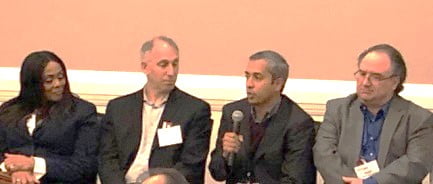
pinfa-NA (pinfa North America) held its sixth industry workshop in San Jose California, April 30 – May 1, 2019, on fire safety for green electronics. SAMPE (Society for Advancement of Materials and Process Engineering) and SPE (Non Halogenated FR Special Interest Group) were co-sponsors of the event. In addition to two lively panel discussions, the fifty attendees gained timely insight from twelve experts representing organizations including Hewlett-Packard, IBM, Corning, Underwriter Laboratories, Texas Instruments, State of California Toxic Substances Control, MaterialWise, Sabic IP and others.
A primer on FRs and FR materials was provided by consultant Dr. Kelvin Shen and Dr. Alex Morgan of University of Dayton Research Institute. Keynote speakers included Dr. Karen Matthews of Corning and Matthew Boday of IBM. Dr. Matthews discussed Industry 4.0 or the 4th industrial revolution and how smart factories will dramatically change manufacturing practices. With connected smart “things” going forward, there will be a prevalence of inter-networking of devices, equipment, processes and factories. It was stated that IoT (“Internet of Things”) will present an overall $1.5T market opportunity in 2025 while the second largest sub-segment “connected industry” will represent a $310B market by 2023. On the topic of IoT E&E devices, there will be over 20 billion active connected devices globally by 2025.
Doug Sober (Essex Technology), Roger Tietze (PART Consulting), Ralph Buoniconti (Sabic) and Tom Fabian (UL) shared the history and challenges of the adoption of non-halogenated flame retardants in CCL (copper clad laminate printed circuit boards) and components in the electronics industry. Over the last decade, there has been enormous progress in the development and application of flame retardants based on phosphorus, nitrogen or inorganic materials. In several cases, these materials bring technical advantages such as higher dimensional stability of printed circuit boards, higher glass transition temperatures or higher resistance to arcing in addition to sustainability benefits.
Jason Ord of Hewlett-Packard discussed the need of the IT industry for safer chemicals information. He stated one important step forward is introducing hazard assessment methodology into eco-label standards (e.g. TCO, EPEAT). It was also stated that use of the chemical hazard assessment tool GreenScreen yields good information. The PC industry strongly recommends that flame retardant manufacturers procure and make public GreenScreen assessments available at www.greenscreenchemicals.org and other public registries. He also lauded pinfa member companies for taking progressive steps in that direction.
Workshop website https://www.pinfa.eu/mediaroom/fire-safety-in-greener-electronics/
Short video: www.beard.de/2019-05_pinfa_SanJose/pinfa_GreenElectronics_SanJose_2019-05_low-res.mov
Photo: Adi Narayanan of Google fields a question during a panel discussion concerning fire safety in green electronics at the San Jose, California, workshop 1st May 2019